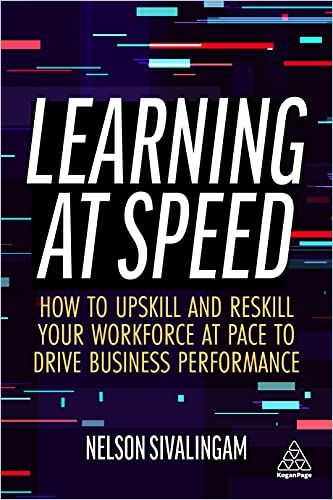“You Have to Deliver Learning with Minimal Friction.”

Nelson, many Learning and Development (L&D) departments are transforming significantly. They’re shifting from the traditional approach of internally creating learning content tailored to specific job roles or departments. Instead, they’re embracing a new mindset of curating existing learning resources to meet the unique needs of individual learners. However, this transition has proven challenging for many in the field. Could you shed some light on why this shift is so tough?
Nelson Sivalingam: The challenge largely stems from the need to demonstrate the value of L&D and its role within the broader business context. Historically, L&D has often been one of the first areas to be cut when budgets are tightened. This perception creates a constant pressure to prove our worth. And while the traditional mindset focused on output, where producing a large volume of programs and courses was equated with providing substantial value, today, it’s all about the outcome. It’s no longer about how much you produce. It’s about the learning impact.
Can you explain this in more detail?
In the recent past, the primary concern for businesses was compliance, with L&D outcomes mostly revolving around meeting legal requirements. Other than compliance, we heard the question, “What else have you accomplished?” – and the answer was typically, “I’ve created 100 programs.” This emphasis on output led our teams to operate like production facilities: We invested in tools to facilitate content creation and managed logistical aspects such as classroom bookings and catering for training workshops. That’s why the skill set within our teams became very production-oriented, with instructional designers focusing on mastering authoring tools and content creation instead driving behaviour change and business outcomes. Now, things are different. We have to explain whether our efforts contribute to the desired outcomes. Are we effectively addressing the business challenges and cultivating the necessary skills within the organization? These questions are outcome-focused, and many L&D departments struggle to answer them sufficiently.

What can L&D professionals do to make the transition easier?
Embracing an outcome-focused approach requires a shift in mindset, necessitating bringing the entire business along on this journey. Companies had grown accustomed to what they believed was the norm, so transitioning is challenging. However, it’s important to remember that we often make the mistake of persisting with something solely because we’ve invested time, money, and effort into it. In both life and business, there are instances where it’s wiser to step away from something that isn’t yielding results, even if it means letting go of past investments.
Indeed, there’s rarely an ideal moment for such changes. Plans are made years in advance, and contracts are in place. Adjusting or scaling down existing programs while simultaneously ramping up new initiatives is challenging.
Absolutely. Everyone hates change, even the people who say they don’t. But when a big change makes the current status quo unacceptable, it can introduce an opportunity or threat. At that point, not changing becomes a bigger risk. It reminds me of a saying from a friend of mine: “You must be willing to give up who you are today to become who you can be tomorrow.” This holds true for L&D.
The main problem with the old approach, you write in Learning at Speed, was that while it enabled targeted learning, it was never scalable – and therefore relatively slow and expensive. Can you give us some numbers here?
Indeed, one critical statistic to consider is the substantial amount of money being allocated.
Last year, we globally spent over $360 billion on L&D. This is expected to increase to $490 billion by 2028. This is more than the GDP of 160 countries! Nonetheless, when asked, only 12% of workers report applying the learning and gaining relevant skills.
So, in essence, 88% of learners engaged with the content – and we could have a whole conversation about the terribly low engagement rates on top – found the provided offers ineffective in improving their skills or performance. That’s why slightly over 80% of employees would not recommend their L&D department or its offerings.
Which is nothing short of devastating.
Yes. But, at least, it highlights that our current approach is not yielding the desired results. Imagine if this was a Net Promote Score (NPS), a measure of a customer’s likelihood to recommend your product or service. Now, as professionals in the L&D field, our “product” is the learning experience individuals engage with to enhance their performance. A low “NPS” of only 20% of users recommending our service indicates that our product is not meeting their needs effectively. This should serve as a clear signal that we need to take action. Here, learning experience platforms (LXPs) come into play.
LXPs promised a technological solution to address underlying issues like the amount of content, just-in-time delivery and pedagogy. Yet, as you said and as is an open secret in the business, the engagement rates are dropping even though many companies have introduced LXPs to their people since COVID-19.
I think that, without a doubt, LXPs are part of the answer. Often, we fall into the trap of assuming that more “interactive and fun content” is the answer. Will adding humor or making content funnier – “We asked for feedback, this is what we got, so add some jokes!” – solve the problem? No, it doesn’t.
The real issue often lies in the context. We overlook the importance of understanding who the learner is, why they need a particular skill, their environment, team dynamics, and the tools they use.
Focusing solely on content without considering these contextual factors is akin to putting a fish out of water – it doesn’t thrive. Content must be designed and delivered within the appropriate context to have a lasting impact. Otherwise, it’s like playing Bingo, where only a few numbers win when called out, but most lose, wasting time and resources.
Yet, many L&D professionals, particularly those accustomed to the old ways, might not even know how to ask the right questions to make better decisions regarding targeting content. What are your three best practices here?
Let’s break it down: What are we trying to achieve? We aim to connect the right learning resources with the right individuals at the right time. If we can accomplish this effectively, we’re succeeding in engaging our learners, right? So, the first best practice is recognizing that the relevant learning doesn’t reside in a single location. Rather than viewing learning as merely a repository of courses, consider it as an ecosystem.
Learning resources exist in various forms and are scattered across a range of sources – inside and outside of the organization. To start, identify this ecosystem, shape it, and streamline access to reduce friction for learners. Technology can play a significant role in integrating and organizing this diverse ecosystem.
At HowNow, for example, we work with our customers to seamlessly integrate and use AI to automatically tag and organize a company’s learning ecosystem based on their skills framework, enhancing relevance and accessibility.
Ok. So, the ecosystem is the foundation. But how do you make learning within the ecosystem productive so you raise your “NPS?”
You have to deliver learning with minimal friction. That’s the second best practice: Our goal should be to integrate learning seamlessly into existing habits because forming new habits can be challenging and add an extra barrier. Instead, why not incorporate access to relevant learning into the tools and applications your employees already use? If someone uses Slack daily, let them access learning there! If Google Search is a daily tool, allow them access learning through it. Embedding learning in the context where work happens is a technological challenge that new technology can certainly address. It’s strongly related to best practice number three: segmenting your target audience effectively.
This seems to be one of the biggest challenges, but at the same time, it is the new normal for L&D managers since one can hardly automate the process or only once the “manual work” has been done, right?
I agree. It’s all about recognizing that not all learners have the same work history, skills gaps, or work in the same manner. To get up to speed, leverage the wealth of data within your organization. Speak to individuals with access to this data and understand your business’s unique needs. For instance, if you aim to improve sales performance, don’t immediately build a generic sales program. Instead, consult the sales leader to identify specific metrics, such as reducing the sales cycle or improving win rates. These data-driven insights will allow you to pinpoint the right audience. Perhaps you should focus on those taking longer than average to close deals. Or, to give another example, you might want to address burnout among a specific group. To achieve this, start by examining the people sending emails and messages via platforms like Slack or Teams outside of regular working hours. This data isn’t complex to obtain, and it’s readily available within the tools your organization already uses.
So, there is a new need for bold decisions and actions within L&D. For instance, when you discover that certain leaders are sending emails or messages during non-working hours, you must address this issue and make clear that such behavior is unacceptable in line with the corporate culture. Yet, as an L&D person, you might not always feel like the boldest person in the room.
Here, we get to the core of the new self-conception as an L&D person in charge: You must focus on outcomes and continuously iterate until a problem is solved.
If a solution isn’t effective, there’s no value in scaling it.
The mindset shift also requires recognizing that it’s not about creating a solution and hoping it works; it’s about actively working towards solving the problem. Ultimately, it’s about empowerment: The business will buy into this mindset shift when they see your role is about helping them achieve their KPIs by providing the specific skills they need. It’s similar to a sports coach identifying weaknesses in a team’s defense and taking steps to address those weaknesses. In this context, your role transforms into that of a skill-builder rather than just a course creator, making you a valuable asset to both employees and the business. In fact, it’s the role L&D leaders always wanted – but often couldn’t prove their effectiveness. Now they can. And they should!
This year, the evolution of AI comes into play to help. It promises to solve many targeting and content relevance problems through adaptive learning. First, what is adaptive learning?
Adaptive learning is all about tailoring the learning experience to an individual’s performance and understanding. To put it simply, let’s consider a basic example. Imagine you complete an AI-powered knowledge check, and if you score below 70%, your learning path takes one direction, while those who score above 70% take a different path. Instead of everyone following a one-size-fits-all learning journey, regardless of their comprehension, adaptive learning customizes the upskilling approach based on your pace, abilities, and aptitude.
While adaptive learning isn’t entirely new – in personalized learning, we already hand-crafted these paths, but never to the depth and level of detail required – what we’re witnessing now is a frontier in technology that is reducing the barriers to implementing truly adaptive learning.
And what are the requirements for L&D departments to use it?
To harness the full potential of adaptive learning, organizations and L&D teams need to define their goal, for example, better performance, by emphasizing a performance-focused upskilling approach over content creation. You simply can’t create content for every possible branching path for every individual, as it becomes impractical. Instead, the focus shifts towards performance outcomes. Find out what skills are essential for everyone, then identify the gaps via assessments, and let AI fill them with – at best, excellent – content from your learning ecosystem and LXP as needed. Additional skills may be critical for individual teams – do the same here. This is how adaptive, highly accurate learning plans evolve for each individual. All it takes are clearly defined goals and objectives, a rich and diverse learning ecosystem and the right tech stack.
Do companies need pre-existing data on their employees’ skills, such as skill cards, to make the most of adaptive learning? And if so, how can they effectively implement these data-driven approaches?
Absolutely!
Data on employees’ skills is fundamental for the success of adaptive learning. You can’t help individuals build the skills they need to perform better if you don’t know what skills they have or lack.
It’s akin to trying to improve a KPI without measuring it, and meaningful progress is impossible if you don’t know where you started and where you need to go. Yet, there’s a way to jumpstart this process for companies that lack a skills framework or skill data on their employees: Using AI, you can tap into real-time job market data, analyzing millions of job postings across different sectors and regions to identify the most in-demand skills for specific roles. This macro-level view of skills helps organizations understand what skills are currently valuable for each job. Next, you can leverage your internal HR data to infer employees’ skills based on their work history.
How does it work?
If an employee has held certain positions or job roles, they’ve likely developed skills associated with those roles. This process helps you create a skills framework for each individual in your organization. You can use a 360-degree feedback approach to determine the proficiency level of these skills. This approach combines self-assessment, peer, and manager assessments on a proficiency scale. For example, if an individual rates themselves as a “4” out of 5 but their manager and colleagues assess them as a “3,” you can average these scores to arrive at an objective proficiency level. This identifies who possesses specific skills and highlights skill gaps within the organization, allowing you to align learning efforts accordingly. There’s potential to further automate skills assessment by integrating real-time performance data into the process.
Can you give an example here?
In a sales role, for instance, you can combine data from your CRM system with recorded sales calls and AI tools to assess an individual’s skill level based on performance. This predictive approach to skills assessment holds promise for more automated and data-driven adaptive learning in the future.
The concept of Intelligent Tutor Systems can make these processes more tangible soon: These systems have been around in education for some time, but they are now – AI-powered – posed to revolutionize mentoring and tutoring in the workplace. What’s your take on it?
Without a doubt, this will be a vast new opportunity.
Just imagine an AI-powered mentor who understands your context thoroughly because it’s interconnected with your internal productivity systems, knows how you’re performing, and has insights from your performance management system and work history. When you ask it questions or seek guidance, it doesn’t require detailed prompts – like ChatGPT – because it already has a comprehensive picture of your capabilities.
This mentor can provide tailored, moment-to-moment guidance, shaping or nudging your behavior and decision-making. These ITS also have the potential to democratize high-quality, personalized support and coaching, making learning accessible to everyone. This democratization excites me because it can contribute to greater inclusivity and opportunities for individuals to develop and thrive.
While the potential of such systems is awe-inspiring, it’s also essential to acknowledge the responsibility and ethical considerations they bring. Some of the things you said sound problematic regarding privacy and data security.
Of course. Privacy and data security become paramount when AI knows so much about individuals, company goals and strategies. As with any new technological achievement, we must learn to use it for the best – and to do this, we must avoid infringements and set clear rules. The time for that is now. I have never been called an optimist, but we can manage this. (Laughs.)
Given your insights, the primary learning providers and platforms may eliminate L&D curation efforts. With access to internal and external data, they can personalize learning experiences without learning departments intervening.
I believe there will still be a need for individuals or teams responsible for specific upskilling functions. While some roles, like content creation, may become automated, the core capabilities and the custodians of these functions will persist.
What are your thoughts on the duties of L&D departments ten years from now?
They will operate in a cross-functional capacity, understanding various aspects of the business and orchestrating the manifold elements required for effective learning strategies – their orchestra just got a bit bigger. Their work has many parallels with the role of a conductor already, or, to stay in the business context, with the one of a founder:
Future L&D professionals will be problem-discoverers and problem-solvers working to keep their organizations relevant and competitive in an ever-evolving landscape.
A big chunk of that work is conversations with key stakeholders, bold research and staying at pace regarding their understanding of what’s happening on the ground. There’s plenty to do there, even in an AI-fueled learning world.
About the Author
Nelson Sivalingam is the co-founder and CEO of the London-based edtech platform HowNow. As a learning and technology expert and serial entrepreneur, he also hosts the L&D Disrupt podcast.








